Image diagnoses for "Bubble/Blister"
95 results with 373 images
Results forBubble/Blister

Shingles B02.7

Hidrocystoma D23.L
Hidrocystoma: Survey image: Since about 2 years gradually developing, disseminated, colorless and black-blue, painless nodules of 0.1-0.3 cm size at the bridge of the nose of a 14-year-old patient.

Hidrocystoma D23.L
Hidrocystoma. detail enlargement: multiple, chronically stationary (no noticeable growth), black-blue, 0.1-0.3 cm measuring elevation; small white comedones are also visible.
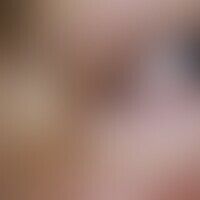
Hidrocystoma D23.L
Hidrocystoma: In this 62-year-old man a solitary, black, calotte-shaped, indolent elevation in the region of the right lower lid, a so-called hidrocystoma noire, has existed for one year.

Acrodermatitis continua suppurativa L40.2
Acrodermatitis continua suppurativa. moderate infestation of the feet. grouped blisters and isolated pustules (Note: in case of so-called dyshidrotic clinical pictures on hands and feet with regular and intermittent pustules, the diagnosis "dyshidrotic eczema" is unlikely. inflammatory plaques aggregated on individual toes.
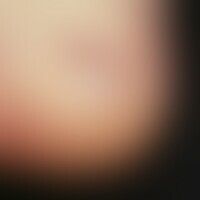
Bubble
bladder. traumatically induced subepithelial bladder in Epidermolysis bullosa simplex. 7-year-old boy, who develops blisters at the heel since the age of 3 years mainly in the warm season after simple exertion. at the upper pole a fresh bulging bladder with a slight inflammatory accompanying reaction is visible. in the picture on the left side a bladder remnant with raised bladder cover is visible. the finding speaks for a traumatic blister formation. since these blisters are induced by banal traumas a corresponding predisposition can be assumed.
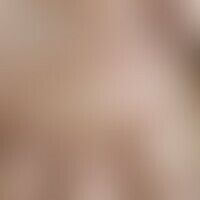
Bubble
Bubbles: areal blistering in Cheiropompholyx. 32-year-old female patient complaining of recurrent blistering on the lateral edges of the fingers. In a very warm outside temperature massive, at first itchy, later painful blistering occurred. Smaller blisters appearing only in the area of the palms (groin skin) (left margin of the picture), which first form flat blister aggregates and then merge into large, blurred blisters (middle of the picture).
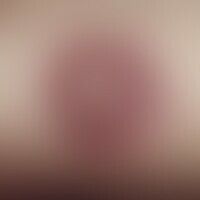
Bubble
bladder. flaccid bladder with a fixed drug reaction. 43-year-old patient who first developed an itchy and slightly painful erythema after taking an anti-inflammatory drug. bladder formation for two days. large, flaccid, brown-red bladder which developed on a brownish-red plaque. the colour of the bladder was caused by haemorrhagic clouding of the bladder contents.
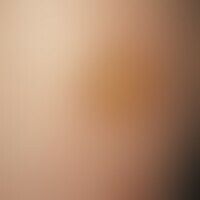
Culicosis bullosa T00.96
Culicosis bullosa. unusually large blister formation after a mosquito bite on the lower leg of an 18-year-old woman. Typical is the "sudden" blister formation on otherwise unchanged skin.

Dermatitis bullosa pratensis L23.-
Dermatitis bullosa pratensis: Stripy, itchy and burning erythema with blistering on the leg after a walk through a high meadow with subsequent tanning.

Dermatitis herpetiformis L13.0
Dermatitis herpetiformis. disseminated, mostly eroded papules (vesicles not detectable here!) on the elbow and the extensor side of the forearm. recurrent course for months with tormenting, prickly itching.
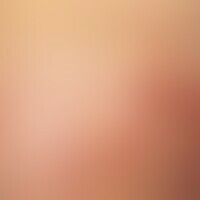
Dermatitis herpetiformis L13.0
Dermatitis herpetiformis. grouped, urticarial papules with erosions and crusts of 2-4 mm in size on light to deep red erythema. in the centre smaller polygonal vesicles. the colourful juxtaposition of different efflorescences is characteristic of dermatitis herpetiformis.

Dermatitis herpetiformis L13.0
Dermatitis herpetiformis. 3 months recurrent, disseminated, papules and vesicles on distinct erythema in a 59-year-old patient. in several efflorescences a blown off halo (bright rim) is visible. at the right border of the picture several fresh, barely 1 mm large reddened papules. the symptoms are described as unpleasantly stinging. no gastrointestinal symptoms.

Dermatitis herpetiformis L13.0
Dermatitis herpetiformis. multiple, disseminated standing, itchy, scratched excoriations on the right arm of a 15-year-old patient. the scratched excoriations are located at sites where grouped vesicles had appeared a few days before. overall, the disease has existed for several months and shows a chronically recurrent course.
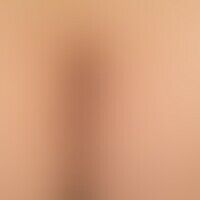
Dermatitis herpetiformis L13.0
dermatitis herpetiformis. multiple, itchy, scratched excoriations on the buttocks of a 15-year-old patient. the scratched excoriations replaced grouped blisters that had appeared a few days earlier. overall, the disease has existed for several months and shows a chronically recurrent course.

Dermatitis herpetiformis L13.0

Dermatitis herpetiformis L13.0
Dermatitis herpetiformis. detailed view of several, chronically active, disseminated papules, red spots and vesicles localized at the integument and accompanied by severe pruritus. characteristic is the occurrence of different types of efflorescence. similar skin lesions are also found gluteal and on both thighs.

Dermatitis medusica L24.8
Dermatitis medusica: Acute, linear, itchy and burning (also painful) plaque, as well as disseminated, papules and vesicles, appearing on the thigh of a 32-year-old woman about 6 hours after contact with a fire jellyfish (Baltic Sea); the stripe pattern is evidence of exogenous triggering.

Dermatitis medusica L24.8
Dermatitis medusica: In this general view, 3 weeks after the contact event, a solitary, linearly shaped, rough, strongly increased in consistency, flatly elevated, finely lamellar scaling plaque with scabbing in a 50-year-old man is shown. During a Mediterranean holiday, painful punctures on the back caused by contact with a jellyfish were first shown. The tentacles of the cnidarian could only be removed from the back with difficulty, then formation of bleeding at the adhesion sites. Immediately after contact, formation of streaky, pale erythema.

Phototoxic dermatitis L56.0

Phototoxic dermatitis L56.0

Phototoxic dermatitis L56.0

Phototoxic dermatitis L56.0

Solar dermatitis L55.-
Dermatitis solaris: flat, sharply defined, painful erythema on the back, 10 hours after prolonged exposure to the sun.

Solar dermatitis L55.-
Bullous Dermatitis solaris. multiple, acute, generalized, 24-hour-old, 0.3-3.0 cm large, isolated and grouped, red, bulging blisters (II degree burns) occurring in UV-exposed areas, localized on a large, homogeneous, painful erythema.